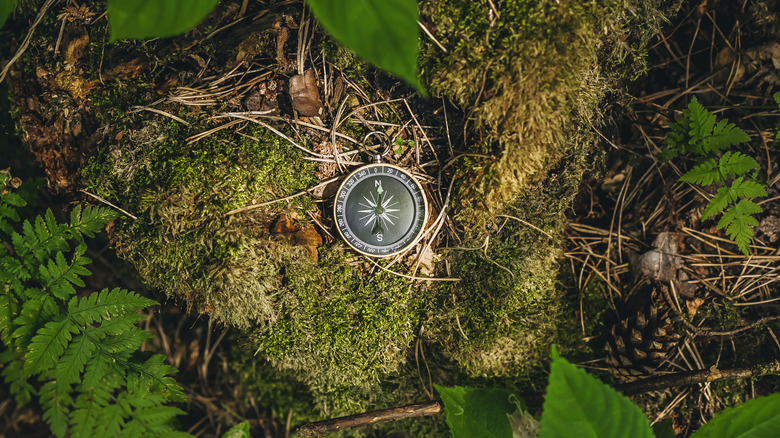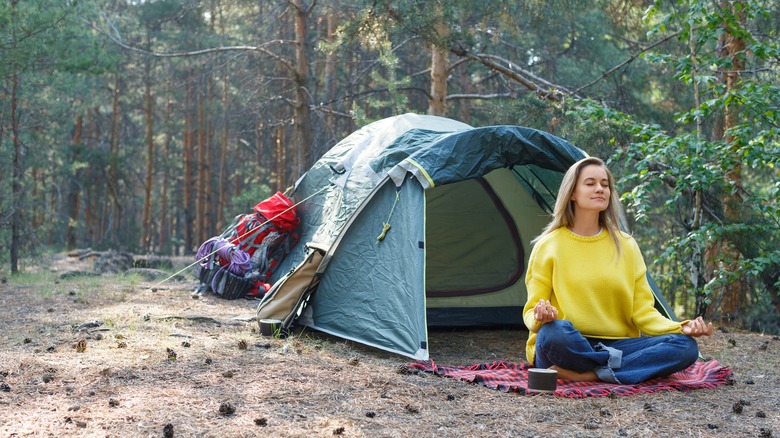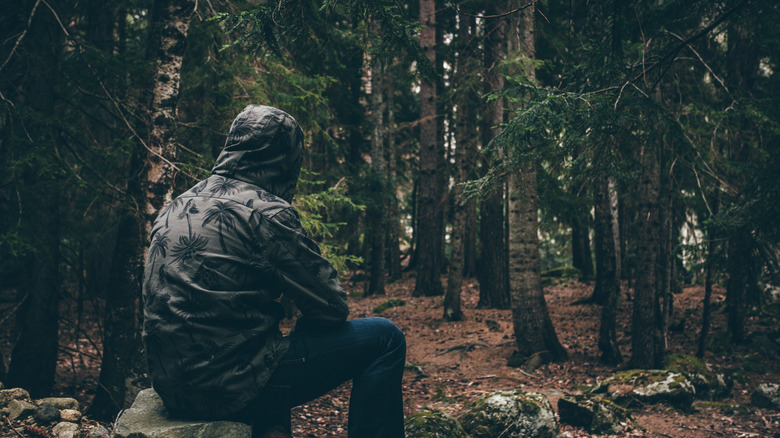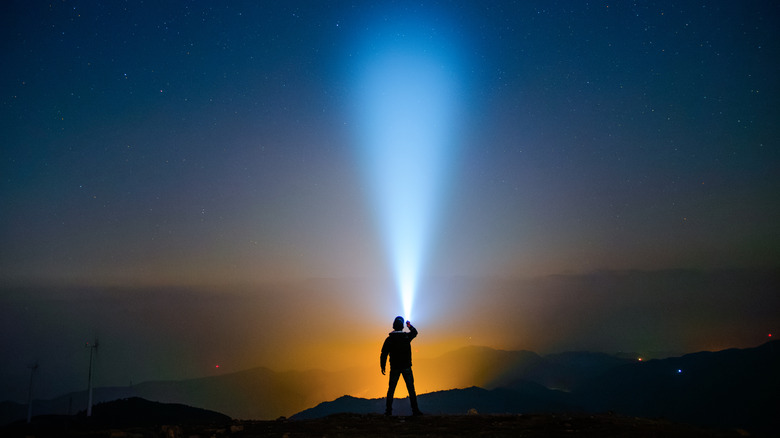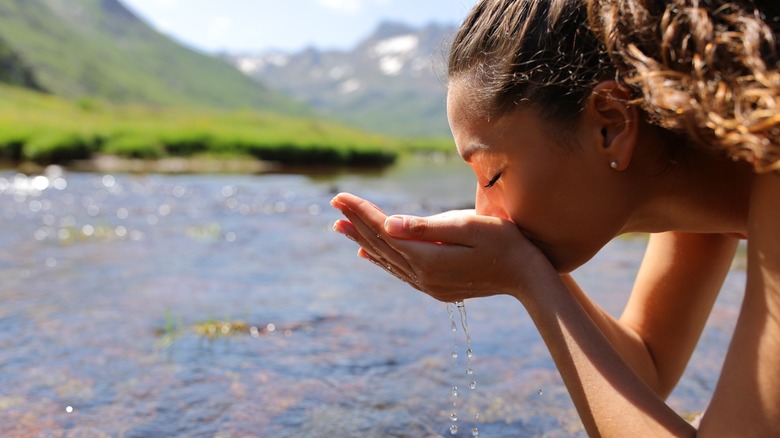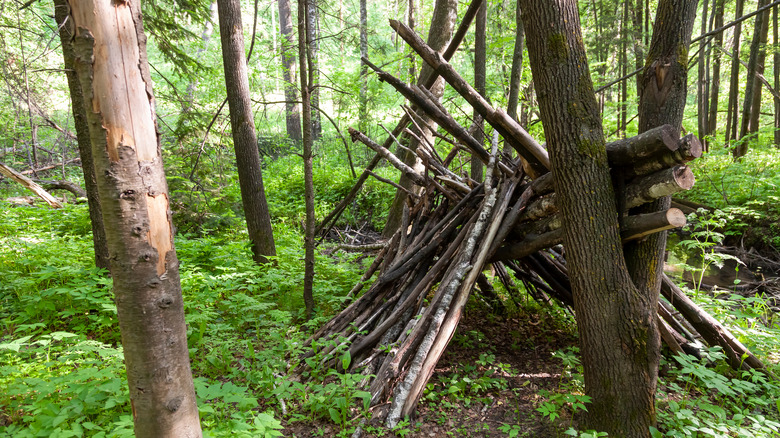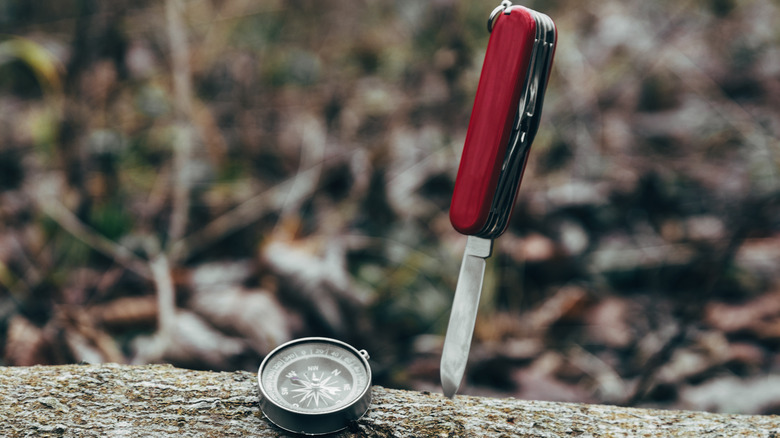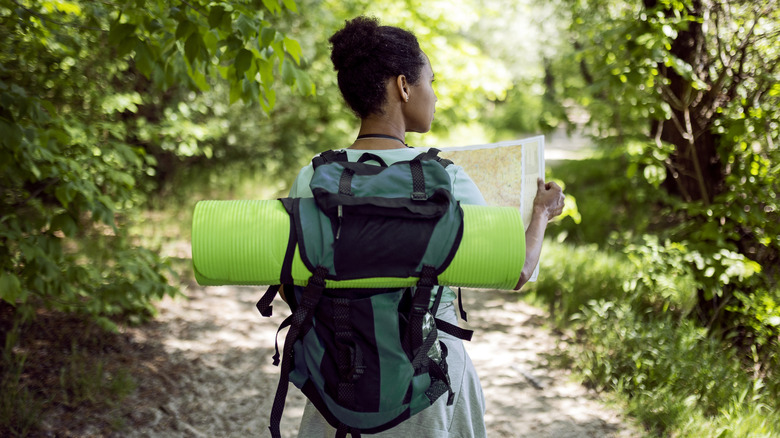Take These Steps If You Get Lost In The Woods
A walk through the woods can be a nice escape from the hustle and bustle of everyday life. However, any otherwise enjoyable experience can take a dark turn when things don't go according to plan. Getting lost in the woods is no one's plan. Unfortunately, it does happen.
According to Survival Dispatch, a study done by Yosemite National Forest Search and Rescue found that each year, around 4,661 people got lost in the woods and required some form of assistance to find their way out. Out of those who got lost, 48% were hikers. There is a season for going missing. It seems that most people who get lost do so between June and September. Even though, because of the weather, foliage, and shorter daylight hours, February and March are considered the most dangerous hiking months out in the woods.
There are many reasons one could get turned around while in the woods, but the important thing is finding a way back out. So, what steps should a person take to get out safely if they get lost in the woods?
Stay calm
As with other emergency situations, the most important thing a person can do is to stay calm. A positive mental attitude makes for clearer thinking and better decision-making. Whether you're taking a solo backpacking trip, or hiking with a group of friends, getting lost can be scary, but it's important to remain in control of those emotions in order to get back to civilization.
Distress can be a reason someone gets turned around in the woods, to begin with, but it won't help them find their way out. If a hike goes on a little too long, or it just becomes difficult to remember where you've been to find where you're going, pause for a moment and breathe. Breathing exercises in times of stress can actually help a person feel a sense of calm and well-being. It can also help lower the heart rate and boost physical energy — which will come in handy at this particular moment. It may seem like staying calm won't necessarily help someone get out of the woods if they're lost, but it could be one of the most important steps to take.
Observe your surroundings
This one may seem obvious, but never undervalue the necessary steps of survival. After grounding yourself and finding mental clarity, take a few moments to observe your surroundings right where you are. Look for any trail markers, streams, specific trees, rocks, or markings. Does a tree near you have a branch that looks a little odd compared to the rest? Make a mental note of it.
A compass is a hiking essential in an emergency. If you didn't pack one, there may be one available on your smartphone. Use your compass to determine direction based on where you're at in that moment and memorize your position. When observing your surroundings, use all of your senses. Listen for any identifying sounds. Is there a stream, or a road nearby? Maybe you hear equipment of some sort in the distance. Listen for sounds that will help you remember your position, but also listen for any sign of humans or civilization. All of this will work with you as you try to strategize your next steps.
Know when to stay put
The first thing one may want to do when lost in the woods is to immediately try to find their way out. However, knowing when to stay put can keep you safe and in many cases, keep you alive. Circumstances in which it's best to stay in one place may include loss of daylight. You won't be able to do much good for yourself wandering through a pitch-black forest.
If you aren't equipped with a compass or other necessary supplies, you're probably not equipped to go venturing further into the woods either, so it's best to stay where you're at. If you've hurt yourself in the middle of a solo hike, in many cases trying to continue will only make any injuries worse. On the other hand, if you were hiking with a group, there's a high chance they've noticed that you're missing and are retracing their steps to find you. If you wander off, they may pass your location and never realize you were there.
Increase your visibility
If you're lucky enough to have never been lost on a hike before, you may have wondered why hiking gear is often made in vibrant color schemes. As it turns out, you may want to wear something bright when hiking for your own safety. When lost in the middle of the woods, there are a lot of the same colors all around you, standing out among them all will help search and rescue find you more easily.
The trick is to make yourself as visible as possible. This means through sight, sound, and anything else that would help someone find you. If you packed a whistle with your gear, now is the time to use it and let any other hikers who may be in the area know that you need assistance. Make any bright layers you have as visible as you can, so that you stand out. If you're in a safe spot to do so, build a fire or create smoke by placing green branches and wet wood over your fire. The smoke will work its way upward, increasing your odds of being spotted by anyone in the area.
Stay hydrated
Dehydration is a dangerous health risk that can impact a person even on their most inactive days. It's even more of a risk when someone is participating in physical activity. If you get lost on a hike, you do not want to become dehydrated. Even if your supplies are running low, the most important thing is to find a way to drink water.
You may have brought water with you, but not enough to account for the extra time you'll be outdoors. If you run out or begin to run low, the best water to drink in the wild may come from nearby rivers, streams, or even rainwater if it rains. You'll need to try to purify any water you collect before drinking it. If you've started a fire, you can boil the water, but even if it looks like it came straight out of a water bottle, it should be purified. According to the National Park Service, water that looks clean can still be contaminated with bacteria, viruses, and parasites. Falling ill is just about the last thing anyone needs when lost in the woods.
Make a shelter or camp
You're calm and visible and have less risk of becoming severely dehydrated, but still, you're lost. At this point, you may realize that the day is rapidly turning into nightfall, or the weather conditions may take a harsh turn. Exposure to the elements or being at the mercy of the forest's darkness will only worsen a bad situation. So, with what light and energy you have available, it's time to find or make a shelter.
If you weren't planning on camping, likely, you don't have a tent so you'll need to find natural shelter. Find a place under a tree or cover. Look around for material you can use to keep yourself from being directly on the ground. For this, you can use moss, leaves, or branches, all of which are good for insulation and even a makeshift bed. If you have multiple layers, fill the space between them with moss or leaves to help keep yourself warm through the night or during bad weather conditions.
Make a self-rescue plan
If after much consideration, you conclude that you're confident and able to navigate your way out of the forest, you can begin the planning stages of self-rescue. Start by marking where you're currently at. If you've made yourself a shelter, this is a good mark. If you haven't already, make a noticeable pile of leaves, branches, or rocks. Create something that isn't likely to get knocked over by wind or rain so you don't lose your starting point.
When getting ready to embark on a self-rescue it will behoove you to repair any minor problems before they turn into big problems. If you're cold, add some foliage in between your layers. If you're thirsty, be sure to hydrate and fill any water bottles you have with you. Make sure you carefully plan out what you're going to do with how much daylight you have left. If you don't have long, or if it's already beginning to get dark, it may be best to wait until the morning.
Strategically find your way out
The preparations are complete, and the time has come to find your way out of the woods on your own. From the very location you've been waiting for rescue, begin hiking one by one in each direction. Start by going no more than five minutes in each direction. You can decide what direction to head in first by basing it on which way you feel will most likely lead you out.
As you go along, be sure to mark your path clearly and often. After continuing in one direction for five minutes, turn around and head back to your original spot before repeating the same steps in another direction. After walking each way for five minutes, begin again. Only this time, walk for ten minutes each way. Again, mark as you go. Repeat this until you find a trail, landmark, or your way out. If you've been unable to call for help due to hiking in an area with no service, check your phone periodically for a signal. If you have a whistle, be sure to blow it to alert anyone who may be nearby. By keeping at this for as long as you have the energy, the water, and the daylight, you may be able to navigate your way to being found.
